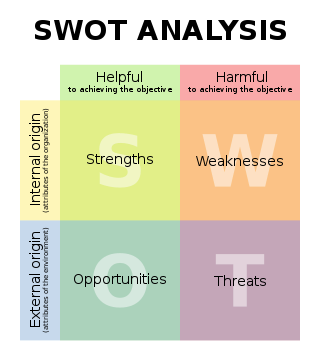
In the field of management, strategic management involves the formulation and implementation of the major goals and initiatives taken by an organization's managers on behalf of stakeholders, based on consideration of resources and an assessment of the internal and external environments in which the organization operates. Strategic management provides overall direction to an enterprise and involves specifying the organization's objectives, developing policies and plans to achieve those objectives, and then allocating resources to implement the plans. Academics and practicing managers have developed numerous models and frameworks to assist in strategic decision-making in the context of complex environments and competitive dynamics. Strategic management is not static in nature; the models can include a feedback loop to monitor execution and to inform the next round of planning.
Marketing management is the strategic organizational discipline that focuses on the practical application of marketing orientation, techniques and methods inside enterprises and organizations and on the management of marketing resources and activities. Compare marketology, which Aghazadeh defines in terms of "recognizing, generating and disseminating market insight to ensure better market-related decisions".
In business, a competitive advantage is an attribute that allows an organization to outperform its competitors.
A core competency is a concept in management theory introduced by C. K. Prahalad and Gary Hamel. It can be defined as "a harmonized combination of multiple resources and skills that distinguish a firm in the marketplace" and therefore are the foundation of companies' competitiveness.

Porter's Five Forces Framework is a method of analysing the competitive environment of a business. It draws from industrial organization (IO) economics to derive five forces that determine the competitive intensity and, therefore, the attractiveness of an industry in terms of its profitability. An "unattractive" industry is one in which the effect of these five forces reduces overall profitability. The most unattractive industry would be one approaching "pure competition", in which available profits for all firms are driven to normal profit levels. The five-forces perspective is associated with its originator, Michael E. Porter of Harvard University. This framework was first published in Harvard Business Review in 1979.

In strategic planning and strategic management, SWOT analysis is a decision-making technique that identifies the strengths, weaknesses, opportunities, and threats of an organization or project.
Porter's generic strategies describe how a company pursues competitive advantage across its chosen market scope. There are three/four generic strategies, either lower cost, differentiated, or focus. A company chooses to pursue one of two types of competitive advantage, either via lower costs than its competition or by differentiating itself along dimensions valued by customers to command a higher price. A company also chooses one of two types of scope, either focus or industry-wide, offering its product across many market segments. The generic strategy reflects the choices made regarding both the type of competitive advantage and the scope. The concept was described by Michael Porter in 1980.
The word ‘dynamics’ appears frequently in discussions and writing about strategy, and is used in two distinct, though equally important senses.
Marketing strategy refers to efforts undertaken by an organization to increase its sales and achieve competitive advantage. In other words, it is the method of advertising a company's products to the public through an established plan through the meticulous planning and organization of ideas, data, and information.
Technology strategy is the overall plan which consists of objectives, principles and tactics relating to use of technologies within a particular organization. Such strategies primarily focus on the technologies themselves and in some cases the people who directly manage those technologies. The strategy can be implied from the organization's behaviors towards technology decisions, and may be written down in a document. The strategy includes the formal vision that guides the acquisition, allocation, and management of IT resources so it can help fulfill the organizational objectives.
The resource-based view (RBV), often referred to as the "resource-based view of the firm", is a managerial framework used to determine the strategic resources a firm can exploit to achieve sustainable competitive advantage.
The knowledge-based theory of the firm, or knowledge-based view (KBV), considers knowledge as an essentially important, scarce, and valuable resource in a firm. According to the knowledge-based theory of the firm, the possession of knowledge-based resources, known as intellectual capital, is essential in dynamic business environments. These resources contribute to lower costs, foster innovation and creativity, improve efficiencies, and deliver customer benefits. Collectively, they are considered key drivers of overall organizational performance. The proponents of the theory argue, that because knowledge-based resources are usually complex and difficult to imitate, different sources of knowledge and intellectual capital can be seen as the main sources for a sustainable competitive advantage.
In organizational theory, dynamic capability is the capability of an organization to purposefully adapt an organization's resource base. The concept was defined by David Teece, Gary Pisano and Amy Shuen, in their 1997 paper Dynamic Capabilities and Strategic Management, as the firm’s ability to engage in adapting, integrating, and reconfiguring internal and external organizational skills, resources, and functional competences to match the requirements of a changing environment.
Competence-based strategic management is a way of thinking about how organizations gain high performance for a significant period of time. Established as a theory in the early 1990s, competence-based strategic management theory explains how organizations can develop sustainable competitive advantage in a systematic and structural way. The theory of competence-based strategic management is an integrative strategy theory that incorporates economic, organizational and behavioural concerns in a framework that is dynamic, systemic, cognitive and holistic. This theory defines competence as: the ability to sustain the coordinated deployment of resources in ways that helps an organization achieve its goals .> Competence-based management can be found in areas other than strategic management, namely in human resource management.
Competitive heterogeneity is a concept from strategic management that examines why industries do not converge on one best way of doing things. In the view of strategic management scholars, the microeconomics of production and competition combine to predict that industries will be composed of identical firms offering identical products at identical prices. Deeper analyses of this topic were taken up in industrial organization economics by crossover economics/strategic-management scholars such as Harold Demsetz and Michael Porter. Demsetz argued that better-managed firms would make better products than their competitors. Such firms would translate better products or lower prices into higher levels of demand, which would lead to revenue growth. These firms would then be larger than the more poorly managed competitors.
Complementary assets are assets that when owned together increase the value of the combined assets. It is defined as “the total economic value added by combining certain complementary factors in a production system, exceeding the value that would be generated by applying these production factors in isolation.” Thus two assets are said to be complements when investment in one asset increases the marginal return on the other. On the contrary, assets are substitutes when investment in one does not affect the marginal return of the other.
Capability management is the approach to the management of an organization, typically a business organization or firm, based on the "theory of the firm" as a collection of capabilities that may be exercised to earn revenues in the marketplace and compete with other firms in the industry. Capability management seeks to manage the stock of capabilities within the firm to ensure its position in the industry and its ongoing profitability and survival.
Digital transformation (DT) is the process of adoption and implementation of digital technology by an organization in order to create new or modify existing products, services and operations by the means of translating business processes into a digital format.

Jay B. Barney is an American professor in strategic management at the University of Utah.
The composition-based view (CBV) was recently developed by Luo and Child (2015). It is a new theory that explicates the growth of firms without the benefit of resource advantages, proprietary technology, or market power. The CBV complements some existing theories such as resource-based view (RBV), resource management view, and dynamic capability – to create novel insights into the survival of firms that do not possess such strategic assets as original technologies and brands. It emphasizes how ordinary firms with ordinary resources may generate extraordinary results through their creative use of open resources and unique integrating capabilities, resulting in an enhanced speed and a high price-value ratio that are well suited to large numbers of low- to mid-end mass market consumers. The CBV has been commented as “a new view with significant application” for emerging market firms and for small and medium sized enterprises in many countries. The view cautions though that composition-generated advantages are temporary in nature and that composition itself mandates special skills in distinctively identifying, leveraging, and combining open or existing resources inside and outside the firm.




